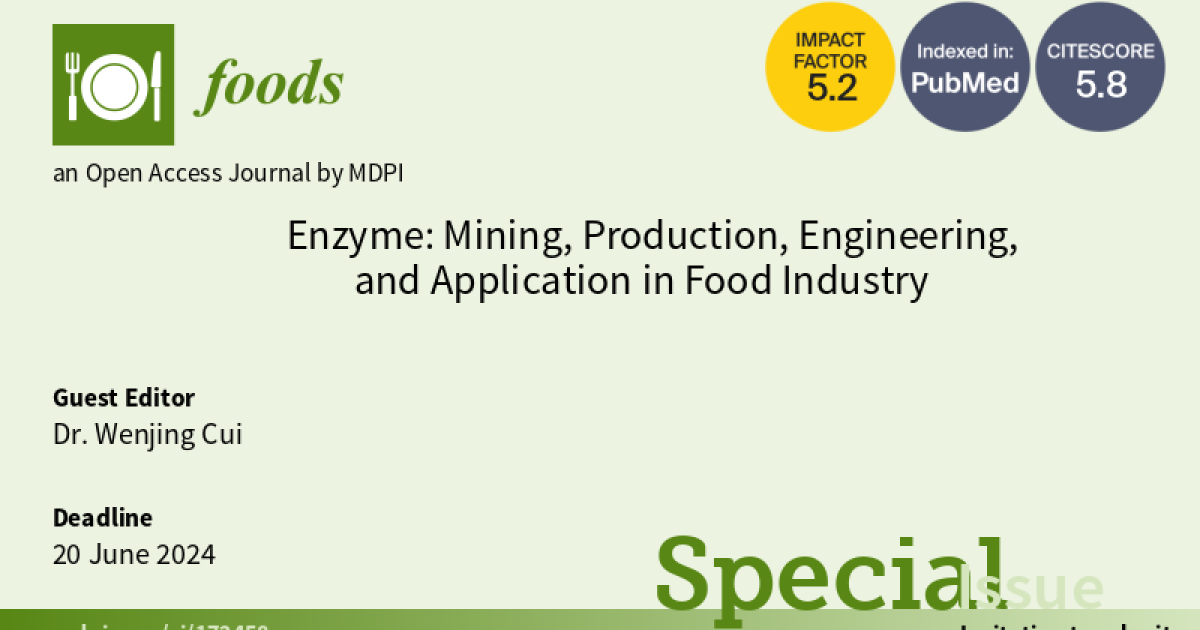Enzyme: Mining, Production, Engineering, and Application in Food Industry
A special issue of Foods (ISSN 2304-8158). This special issue belongs to the section "Food Biotechnology".
Deadline for manuscript submissions: closed (20 June 2024) | Viewed by 7757

Special Issue Editor
Special Issue Information
Dear Colleagues,
For centuries, enzymes, special products originating from microbes, have played a profound role in food processing, production, and manufacturing owing to the positive impact they have on the high efficiency, specificity, and safety of food production. Recently, "future foods" has emerged as a new focus as people seek healthier foods that are more nutritious, delicious, and sustainable; however, the foods produced along these lines retain problems with texture, nutrition, and flavor. Advances in enzyme technology have enabled the development of new tools and approaches with which to better manipulate food textures and nutritional aspects. Thus, the mining, engineering and heterologous production of food enzymes have hugely expedited both traditional food and future food preparation.
In view of this, the Special Issue is inviting author to submit unpublished original research articles, short communications, and mini-reviews. Submissions should focus on topics, including, but not limited to:
- Mining the enzymes, especially from microbes, that have been used for or have potential applications in food processing and production.
- Engineering the enzymes that have been used in traditional food production and future foods, as well as revealing their structure–activity relationship.
- Heterologous production of food enzymes in microbial hosts.
Dr. Wenjing Cui
Guest Editor
Manuscript Submission Information
Manuscripts should be submitted online at www.mdpi.com by registering and logging in to this website. Once you are registered, click here to go to the submission form. Manuscripts can be submitted until the deadline. All submissions that pass pre-check are peer-reviewed. Accepted papers will be published continuously in the journal (as soon as accepted) and will be listed together on the special issue website. Research articles, review articles as well as short communications are invited. For planned papers, a title and short abstract (about 100 words) can be sent to the Editorial Office for announcement on this website.
Submitted manuscripts should not have been published previously, nor be under consideration for publication elsewhere (except conference proceedings papers). All manuscripts are thoroughly refereed through a single-blind peer-review process. A guide for authors and other relevant information for submission of manuscripts is available on the Instructions for Authors page. Foods is an international peer-reviewed open access semimonthly journal published by MDPI.
Please visit the Instructions for Authors page before submitting a manuscript. The Article Processing Charge (APC) for publication in this open access journal is 2900 CHF (Swiss Francs). Submitted papers should be well formatted and use good English. Authors may use MDPI's English editing service prior to publication or during author revisions.
Keywords
- food processing
- food enzymes
- novel enzyme mining
- enzyme engineering
- enzyme application
- heterologous production of food enzymes
- proteases
- carbohydrate degradation-related enzymes
- food bioactive compound synthesizing-related enzymes
- structure–activity relationship
Benefits of Publishing in a Special Issue
- Ease of navigation: Grouping papers by topic helps scholars navigate broad scope journals more efficiently.
- Greater discoverability: Special Issues support the reach and impact of scientific research. Articles in Special Issues are more discoverable and cited more frequently.
- Expansion of research network: Special Issues facilitate connections among authors, fostering scientific collaborations.
- External promotion: Articles in Special Issues are often promoted through the journal's social media, increasing their visibility.
- e-Book format: Special Issues with more than 10 articles can be published as dedicated e-books, ensuring wide and rapid dissemination.
Further information on MDPI's Special Issue polices can be found here.






